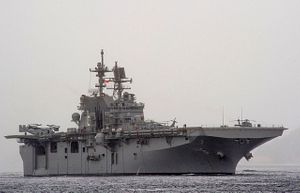A recent report from the Center for a New American Security (CNAS) argues that the United States and its allies can effectively use amphibious assault groups in high intensity conflict against China. While the big, flat-deck amphibs have demonstrated their strategic value through humanitarian assistance/disaster relief (HA/DR) and associated operations over the last decade, the CNAS report (written by Colonel Grant Newsome, USMCR Ret.) argues that they can contribute effectively during wartime conditions.
The report envisions amphibious assaults against Chinese bases in the first and second island chains, operations that would support the cracking of China anti-access/area denial (A2/AD) shell. Amphibious assault ships could also deliver and support defensive systems on allied controlled islands, shifting cruise missile and SAM systems from island to island depending on tactical and operational necessities.
This thinking echoes similar planning during the Cold War. Toward the end of the Cold War, the U.S. Navy and the U.S. Marine Corps developed doctrine for the offensive use of amphibious assault ships against the Soviet Union. Amphibs, supported by carrier and long-range land-based aircraft, would strike at the Soviet periphery during wartime, distracting the Red Army from its tasks on the Central Front.
Analysts debate whether this would have worked; some argue that Soviet anti-access forces would have destroyed any amphibious assault groups before they had a chance to reach shore, and in any case the Soviet police could have simply arrested the relatively small number of Marines that would have landed. Nevertheless, the effort to incorporate amphibious warfare into the broader anti-Soviet war plan paid bureaucratic dividends for the Marine Corps and for parts of the Navy.
In this context, it makes complete sense to think of how amphibious warfare groups can contribute to high intensity maritime conflict between the United States and China. Big amphibs can clearly contribute as light aircraft carriers, operating the F-35B and a variety of anti-submarine and support aircraft, but missions that take advantage of their unique ability to contribute in the littoral would help even more.
But there are some reasons for concern. The Chinese A2/AD system functions primarily through tactical deterrence; American carrier groups stay out of range because they fear the variety of missiles and torpedoes that the Chinese can throw at them. Inevitably, the limited ability of the United States to protect its big ships from attack means that most defensive resources would concentrate around the CVN battlegroups, leaving the amphibs vulnerable. Theoretically, amphibious groups could draw attention away from the big carriers, but then the loss of a big flat-deck amphib would have nearly the same political effect as the loss of a carrier. Moreover, expending the amphibious force in a war against China would leave the U.S. short-handed around the world, where the LHAs can function in their “light carrier” variant.
Qualms aside, however, the report represents a valuable effort to think through the contribution that the amphibious force could make in a war against China.

































